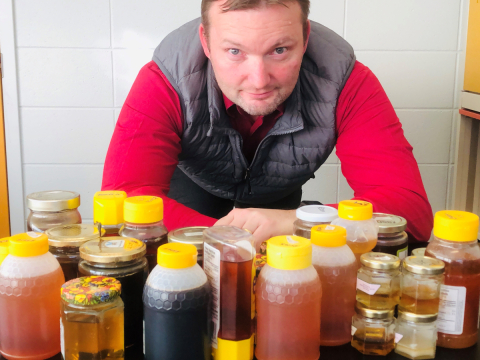
McGill University researchers have developed an AI-powered method to verify the origin of honey, ensuring that what's on the label matches what's in the jar. The breakthrough offers a potential solution to a long-standing problem.
"Honey is one of the most fraud-prone commodities in global trade. It often involves mislabelling where it was produced or the types of flowers that bees collected nectar from," said lead author Stéphane Bayen, Associate Professor and Chair of McGill's Department of Food Science and Agricultural Chemistry.
Honeys made from a single flower are often more expensive, prized for their unique flavours and potential health benefits.
Some producers intentionally mislabel honey in order to charge more, Bayen added, while others may do so unknowingly, given that tracking exactly where bees collect nectar can be challenging.
The new method can determine what type of flowers the bees visited to produce a particular honey, which is important because consumers pay a premium for honey made from the nectar of a single type of flower.
Until now, authenticating honey has been done through pollen analysis, a technique that fails after honey is processed or filtered. The new approach uses high-resolution mass spectrometry to scan honey at a molecular level to create a unique chemical "fingerprint." Machine learning algorithms then read the fingerprint to verify the honey's origin. To check the accuracy of their method, the researchers tested it on a variety of honey samples and compared the results to honey from known botanical sources.
"Right now, identifying the true source of honey can take days. With our method, we can do it in minutes, even for processed honeys where traditional techniques fall short," said Bayen.
Protection for consumers and producers
The scientists say demand for local varieties, like Quebec's blueberry honey, is rising as more people prioritize buying local. The new technique could serve as a safeguard for both consumers and ethical beekeepers.
"People deserve to know that their honey is what it claims to be, and honest producers deserve protection from fraudulent competitors," said Bayen.
The researchers hope to see their technique adopted by food inspection agencies worldwide. Their next step is to explore how it could be used for other food products prone to mislabelling.
About the study
"Rapid Convolutional Algorithm for the Discovery of Blueberry Honey Authenticity Markers via Nontargeted LC-MS Analysis" by Shawninder Chahal and Stéphane Bayen et al., was published in Analytical Chemistry.
The study was supported by the Agilent Thought Leader Award, the Canada Foundation for Innovation and the Natural Sciences and Engineering Research Council of Canada Alliance Project.






